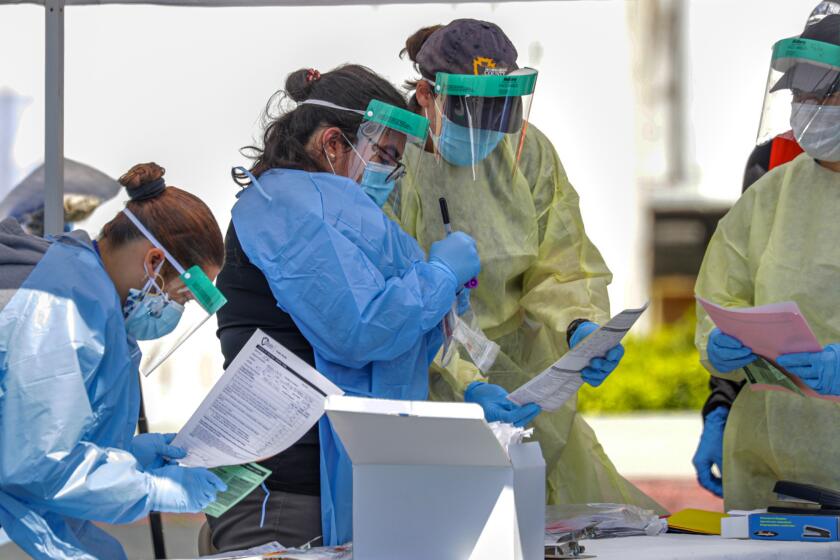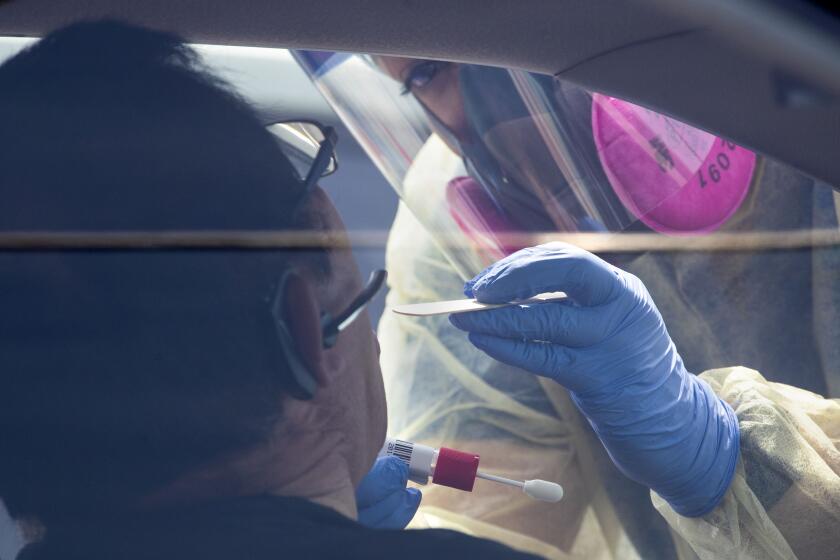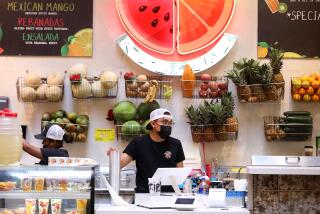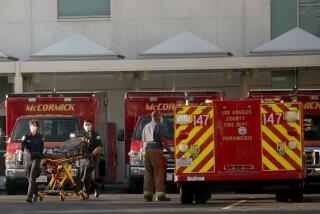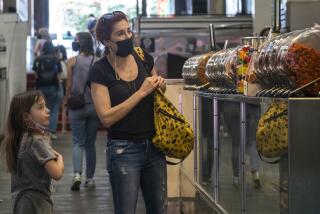With coronavirus testing available for all, L.A. city sites test 10,000 in one day
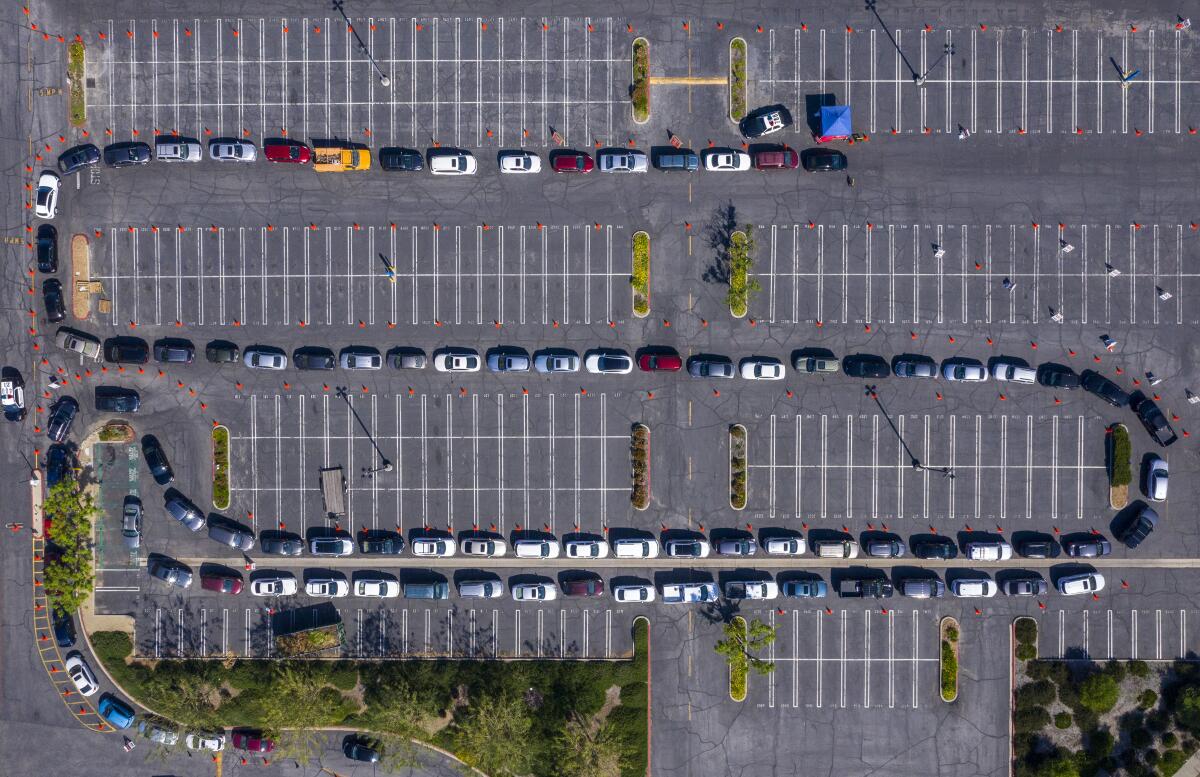
- Share via
California public health officials are urging all counties to expand testing to any residents with symptoms of COVID-19, a sign of their growing confidence that testing capacity has increased enough to handle a significant portion of the state’s population.
According to the new guidelines, symptomatic low-risk people — including young adults without underlying health conditions — are now among the state’s top priorities for testing, along with six other specified groups.
Officials also announced late Wednesday that anyone who works in a high-risk setting, including grocery store employees, bus drivers and law enforcement officers, should also be included among the highest priority to receive routine screenings for the virus.
While California’s largest, wealthiest counties might have the capacity to expand testing, any increase in the number of people who get tested could prove challenging in places such as Bakersfield or Fresno, where testing sites can require a long commute.
California has “testing deserts” in parts of the Central Valley and along the Nevada and Oregon state lines, as well as in dense urban regions with large numbers of minorities, according to data compiled by the governor’s office.
To address the discrepancies, Gov. Gavin Newsom announced six new testing sites prioritizing “black and brown communities and focusing on rural communities.” About 80 others are expected to follow by early May.
Coronavirus tests for all? L.A. County clarifies how residents can get tested
In a message to health agencies and medical workers, the state health department acknowledged that some rural regions and high-density neighborhoods may not yet have the infrastructure and supplies to lift local restrictions. Officials said that the department’s prioritization guidelines should be used “when testing availability is limited” and that the policy “should not supersede the recommendations of a clinician or local health officer.”
Eventually, officials said, widespread testing will help public health departments closely track potential cases, one of the requirements for California to ease into the next phase of the pandemic response. Such tracking will require an army of at least 10,000 contact tracers, Newsom said.
But the governor has repeatedly emphasized that there is a long, methodical road ahead before social restrictions are eased, saying that the spread of the virus will ultimately decide what happens next.
“Politics will not drive our decision-making. Protests won’t drive our decision-making. Political pressure will not drive our decision-making,” Newsom said in a briefing this week. “Dates don’t. But data does.”
In Los Angeles County, any resident, regardless of whether they have symptoms, can be tested for the coronavirus at any city-run testing site.
That news traveled fast after Mayor Eric Garcetti made the announcement Wednesday.
New guidelines call for all symptomatic low-risk people — including young adults without underlying health conditions — to be among the state’s top priorities for testing.
At the West Valley testing site at the Warner Center on Thursday, hundreds of cars snaked through the massive parking lot and nearly completely around the block.
Christy Durham, a West Hills resident, went to the site after her 17-year-old daughter, Madison, signed up online for a test following Garcetti’s announcement.
Durham said she had driven past the testing site on previous days and the lot was never as busy as it was Thursday, with cars waiting in a 1½-mile line.
“The only time it’s that busy is Fourth of July when they’ve got fireworks at Warner Center Park,” she said.
Durham, her husband and their 14-year-old son have appointments coming up in the next few days, but she’s torn about whether to go through the long wait again. The testing process itself for her daughter went smoothly, and the workers were helpful, but it took more than two hours to reach them, she said. There appeared to be only one traffic enforcement officer to help with the mess, she said.
“The horrible thing is, I do think it’s worth it” to go through the wait again, Durham said. “I think it’s worth every L.A. resident being able to be tested. I know that a big part of the economy opening up and businesses starting to open up again is having that testing information, but [the wait] was a lot.”
Garcetti said the city-run testing sites provided about 10,000 tests on Thursday, triple the number of tests usually done in a day. The same day, the county sites tested about 4,000 people, he said.
Garcetti said local leaders believe, cumulatively, they could potentially provide up to 50,000 tests a day if needed, but that level of demand hasn’t presented itself yet.
“We have over 300,000 tests that are stockpiled from the folks that we get the tests from, and it’s not that we’re saying, ‘Hey, don’t give those to other cities or other places, we want them for ourselves for this,’” Garcetti said. “They’re confident that they’re able to continue meeting the demands of others and be able for us to expand the number that we are doing.”
Earlier in the day, L.A. County health officials made it clear that they were not similarly expanding testing criteria.
Dr. Christina Ghaly, director of the county Department of Health Services, said the county would prioritize testing for people with symptoms of COVID-19, including newly recognized symptoms such as sore throat and sudden loss of taste or smell.
The county also will emphasize testing for people working in essential services, including healthcare workers, those who work in food service and utilities, and residents of institutional living facilities, such as nursing homes.
Asked if the county and city were offering mixed messages on testing, Ghaly said the two entities were working closely together on a “rapidly evolving topic.”
“We think that this is the best approach,” Ghaly said. “We also believe that this is what is most supported in terms of the clinical evidence about who would benefit from a test.”
A few hours later, Garcetti brushed off questions from reporters about whether there was any tension between his office and the county regarding the shift in testing policy.
The city consulted with the Los Angeles County Department of Public Health on its plan to test asymptomatic people and received “positive feedback,” Garcetti said Thursday night, while also noting that the county agency doesn’t need to “sign off” on the city’s program.
“When people are eager to get back to work, to open up spaces, that depends on knowledge and knowledge comes from testing,” he said, defending the city’s approach. “And testing more people gives us more ability to open up sooner.”
Times photographer Brian van der Brug and staff writer Dakota Smith contributed to this report.
More to Read
Sign up for Essential California
The most important California stories and recommendations in your inbox every morning.
You may occasionally receive promotional content from the Los Angeles Times.
